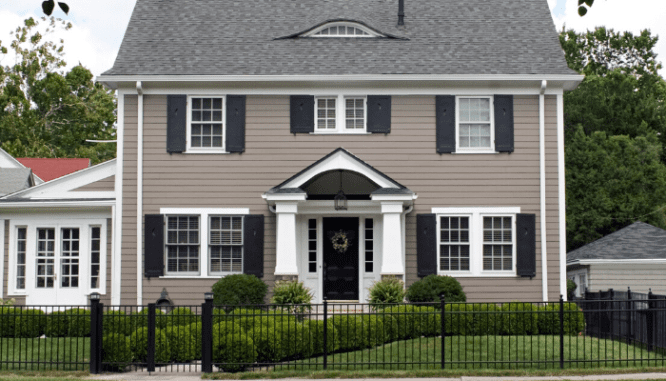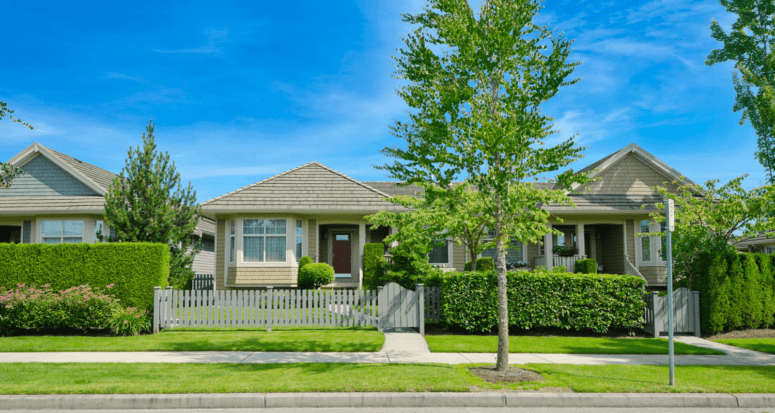HOA Pros and Cons for Homebuyers: Rules, Fees, and Perfect Lawns
- Published on
- 6 min read
-
 Valerie Kalfrin Contributing AuthorClose
Valerie Kalfrin Contributing AuthorClose Valerie Kalfrin Contributing Author
Valerie Kalfrin Contributing AuthorValerie Kalfrin is a multiple award-winning journalist, film and fiction fan, and creative storyteller with a knack for detailed, engaging stories.
You have a good chance of encountering an HOA property while house-hunting: Statistics show that homeowners associations (or HOAs) govern nearly 60% of recently built single-family homes — and 80% of houses in new subdivisions.
HOAs can seem nitpicky when they pop up in the news, such as when a Texas HOA clashed with an Army sergeant in May over how and when he displayed an American flag in the yard.
They also prove ripe for satire, such as when the paranormal investigators on the TV show The X-Files found a life-threatening reason behind one planned community’s covenants, codes, and restrictions (CCRs): a storm-drain monster attacked anyone who didn’t follow the rules.
But HOAs do have their benefits, especially for buyers looking for a low-maintenance lifestyle. “For people who are retiring, they love it,” said Martin Luna, a real estate agent for 24 years who serves Asheville, North Carolina, along with neighboring Madison and Henderson counties.
Let’s sort through the noise (at a reasonable volume) of HOA pros and cons to decide if this type of community is right for you.

What is an HOA, and what does it do?
An HOA is basically a governing structure for a planned community, such as a development of single-family homes, condominiums, or townhouses.
For anyone who’s lived in rental property, consider an HOA like a landlord or property manager: an entity that takes care of certain features to maintain the community and atmosphere in exchange for a fee — and your following certain guidelines.
Roughly one-quarter of the U.S. population lived under some type of community association in 2018, according to the Community Associations Institute (CAI), a provider of resources and information related to community associations, condominiums, and co-ops nationwide and around the world.
Those residents are spread among about 347,000 community associations nationwide, with the most in Florida, California, Texas, Illinois, and North Carolina, the CAI said. (The states with less than 1,000 community associations include Alaska, Arkansas, Mississippi, North Dakota, South Dakota, West Virginia, and Wyoming).
By region, that means that HOAs govern about 33% of homes in the Northeast, about 50% of homes in the Midwest, and at least 75% of homes in the West and the South, this data shows.

The pros: more home value and activities
The CAI’s 2018 Homeowner Satisfaction Survey notes that 85% of residents are satisfied living under a community association, with 63% rating their experience as positive and 22% as neutral.
There are several reasons for that:
1. Make someone else take care of the lawn
Whether you live in a condominium complex or a planned community of single-family homes, an HOA handles a lot of exterior upkeep. “You don’t have to worry about mowing the lawn or doing landscaping. Trimming bushes or trimming trees. Pest control,” Luna said. “It’s very convenient.”
According to FirstService Residential, a Florida-based residential property management company in charge of communities nationwide and in Canada, HOAs also can handle:
- Heating and air-conditioning systems, electrical systems, plumbing, lighting, elevators, and security systems in common areas
- Repairing roads, roofs, walls, and building components (particularly in a condo complex)
- Trash pickup
- Snow removal
- Cleaning and painting building exteriors
- Painting and cleaning common interiors, including floors and walls
2. You could sell for more down the line
Single-family homes under HOAs sell for an average of 4% more — roughly $13,500 more — than similar homes outside of HOAs, according to University of California at Irvine researchers Wyatt Clarke and Matthew Freedman, who in a study published in June 2019 analyzed public home listing data for 34 million housing transactions over 35 years.
This tends to be higher for larger houses and homes in smaller subdivisions, and it declines as homes age, the researchers said.
Part of the reason for this is because of conformity in a planned community: minimum square footage for homes, certain styles of homes, and certain restrictions, such as not allowing livestock in a residential neighborhood or abandoned vehicles in driveways, Luna said.
3. Golf, anyone?
If you like recreation and social options, an HOA can be a boon to your lifestyle. Some HOAs include swimming pools, tennis courts, golf courses, playgrounds, and gyms in their communities — none of which you’ll have to maintain personally. Some also host social gatherings, such as block parties, community yard sales, spring cookouts, pool parties, and nature walks.
4. Cut down on those bills
Although HOAs vary, one cost frequently included in the fees they collect are utilities.
An HOA often takes responsibility for basic water and gas, as well as city services such as sewer, trash, and recycling, says Beier Law, a firm serving Allentown and Pittsburgh, Pennsylvania, specializing in real estate law, family law, and personal-injury cases.
That cuts down on the number of bills you’d pay each month.
5. Conflict resolution helpline
If you’re the type of person who dreads conflict with neighbors, an HOA can advocate for you if, say, your neighbor plays loud music or has a dog that barks at all hours. (Some HOAs don’t allow dogs at all.) Just talk to your HOA about the problem you’re facing, and they’ll take it from there.

The cons: costly fees and meticulous guidelines
1. Ugh…the fees, though
Sometimes called dues, HOA fees are mandatory — and they can be expensive, depending on the community and what the fees include. Researchers Clarke and Freedman in their study said that the fees HOAs charge single-family homeowners average $2,800 per year. They concluded that each dollar in dues bought about $1.19 worth of benefits.
Most monthly assessments are about $100 to $300, with those for condominiums ranging higher than HOA fees, the CAI said. Seventeen percent are more than $500 per month.
In addition to maintenance and upkeep, these fees pay for employees who work for the HOA, as well as money for a reserve fund, typically used for unexpected expenses and emergencies, such as a flood, hurricane, or wildfire, according to the finance website TheStreet.
A 1,000-square-foot condominium in Des Moines, Iowa, charges $100 a month just for utilities, landscaping, and snow removal, according to the financial website SmartAsset. By comparison, a 3,400-square-foot condominium in Hollywood, California, charges $4,000 a month for a host of amenities, including 24-hour concierge service.
Luna said he’s seen HOA fees as expensive as $10,000 per year. “That’s going to affect the budget to buy the house,” he said. “That’s less buying power for some buyers.”
2. Risk of lien or foreclosure
HOA fees are a cost in addition to your mortgage, property tax, and homeowners’ insurance. You’re required to pay these fees, even if you don’t use all the amenities.
And if you run afoul of a particular rule? You could be assessed a fine, such as the Army sergeant renting a home in an HOA that asked him to remove the flag that wasn’t displayed in accordance with the community’s guidelines.
If you can’t or don’t pay these fines or the regular fees, you run the risk of the HOA placing a lien on your property or losing your home to foreclosure.
The CAI noted in a news release that a lien or foreclosure should be used as a last resort. However, homeowners who refuse to pay their assessments — “as they contractually agreed to do when they purchased their homes in an association — are cheating their neighbors, their community and themselves.”
In other words, the HOA has to make up the difference when people don’t pay their obligations, so they’ll place a lien on your property with the ability to foreclose to ensure that you do.
3. Put away the orange paint…
HOAs have meticulous guidelines, particularly about homes’ exteriors.
The Westchase Community Association in Tampa, a master-planned, deed-restricted community of about 3,500 homes over 2,000 acres, has an approved exterior paint color palette that lists Sherwin-Williams paint names and reference numbers for accuracy, although residents can use any brand that matches these colors.
New residents also receive a heads-up about some common violations of deed restrictions:
- A garbage can in view of the public or a neighbor
- “Unkempt conditions” such as mildew or peeling paint on a home or mailbox
- Having a pet off its leash or not picking up after a pet
- Leaving sports equipment out after certain hours
- A dirty driveway or sidewalk
Your neighbors in an HOA-managed community also might be a little close for comfort. Research shows that HOA homes have about 20% more floor space than those not within an HOA, but they’re situated on smaller parcels (admittedly, more likely to be waterfront or within access to a golf course).
4. All those rules about a house you own
That limited personalization ties into the overall aspect of following an HOA’s rules. You might not mind abiding by a list of paint colors or how many vehicles you can park in your driveway, but other CCRs have limits such as:
- the dimensions of your fencing (for instance, that fences shall be black aluminum residential grade, with posts spaced six feet apart)
- how tall your grass can grow
- what type of fertilizer or sprinkler system you can use in the yard
- the size and composition of any garden you’d like to have
- the types of window coverings that face the street
- the number of pets you can have, as well as the maximum amount they can weigh
- the dimensions and required way to post a “For Sale” or “For Rent” sign
Those guidelines help with the overall property values, but residents can chafe at them. In the CAI’s homeowner satisfaction survey, 16% of respondents listed “restrictions on exterior home improvements” as one of the “worst aspects of living in a community association.” Other respondents were more specific, singling out restrictions on parking (8%), restrictions on landscaping (8%) and “the rules” (5%).
In fact, one of the top seven reasons that residents sue HOAs is because the HOA denied a homeowner’s architectural idea, according to the publication HOAleader.com.
5. Who’s the boss?
Like any governing body, an HOA can be efficient and professional, or it can mismanage the community or misspend money. The top reason HOAs face lawsuits is a failure to repair, maintain or replace “common elements or units,” like a leaky roof in a condominium.
If your HOA lacks money in its reserves for emergencies or is in financial trouble, it can authorize a special assessment to pay for certain projects or increase monthly dues.

How to decide whether an HOA is right for you? Read the fine print
If a home in a planned community catches your interest, be sure as part of the disclosures to ask for the HOA’s declaration or master deed, as well as answers to standard questions, such as the HOA’s financial status and whether the home you like has any outstanding debt to the association.
These disclosures should indicate how often the HOA has increased dues and assessments — and how often it’s allowed to do so, according to Richard B. Linderman, partner in Ansell, Grimm Aaron’s Community Association Practice Group.
Read over the CCRs — ask for a printed copy if the HOA doesn’t post them online — and also look at the community with a careful eye.
“Are they failing to provide regular lawn care or landscaping? Failing to fix broken walkways or roads? It’s very important to ask the residents who live there what their opinion is of the management,” Luna said.
Lastly, review your budget, your lifestyle, and your personal preference for detail. While having use of a pool and clean nearby parks might hold strong appeal, noting to pull in the trash cans or the kids’ bicycles by a certain time might be something you don’t want on your to-do list.
Header Image Source: (romakoma/ Shutterstock)
